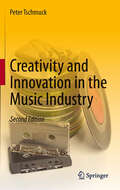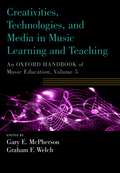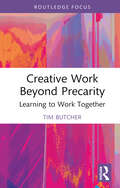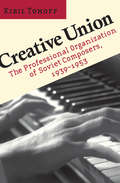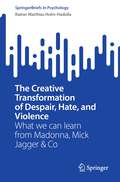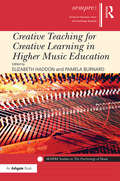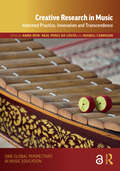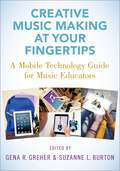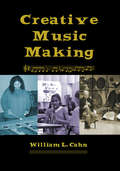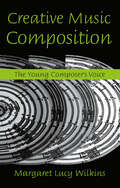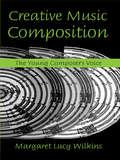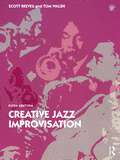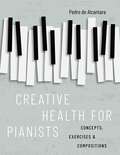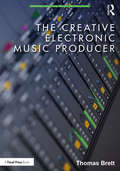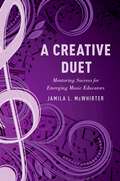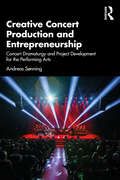- Table View
- List View
Creativity and Innovation in the Music Industry
by Peter TschmuckWhy did jazz become a dominant popular music genre in the 1920s and rock 'n' roll in the 1950s? Why did heavy metal, punk rock and hiphop find their way from sub-cultures to the established music industry? What are the effects of new communication technologies and the Internet on the creation of music in the early 21st century? These and other questions are answered by Peter Tschmuck through an integrated model of creativity and innovation that is based on an international history of music industry since Thomas A. Edison invented the phonograph in 1877. Thus, the history of the music industry is described in full detail. By discussing the historic process of music production, distribution and reception the author highlights several revolutions in the music industry that were caused by the inference of aesthetic, technological, legal, economic, social and political processes of change. On the basis of an integrated model of creativity and innovation, an explanation is given on how the processes and structures of the present music industry will be altered by the ongoing digital revolution, which totally changed the value-added network of the production, dissemination and use of music. For the second edition, the author has reworked chapter 9 in order to include all the developments which shaped the music industry in the first decade of the 21st century – from Napster to cloud-based music services and even beyond.
Creativities, Technologies, and Media in Music Learning and Teaching: An Oxford Handbook of Music Education, Volume 5 (Oxford Handbooks)
by Gary E. McPherson and Graham F. WelchCreativities, Media, and Technology in Music Learning and Teaching is one of five paperback books derived from the foundational two-volume Oxford Handbook of Music Education. Designed for music teachers, students, and scholars of music education, as well as educational administrators and policy makers, this fifth book in the set comprises three complementary sections: musical creativity as practice; music teaching and learning through technology; and the interplay of media, music, and education. The first section reviews notions of musical creativity, examining practice-based perspectives to support and develop understanding of the diverse types of creativity found within music education practice across the globe. In the second section, authors explore the essential role of technology in musical discourse and in various forms of musical learning, even as technology continually evolves and the needs and possibilities continue to rapidly change. The third section provokes readers to assess their own thinking about the transformative changes occurring within the discipline as a result of advances in media, and the increasing infiltration of media into all aspects of life, the classroom, and music making. Contributors Andrew R. Brown, Pamela Burnard, Bernadette Colley, Ian Cross, Rokus de Groot, Steven C. Dillon, Randi Margrethe Eidsaa, David G. Hebert, Evangelos Himonides, Neryl Jeanneret, Ailbhe Kenny, Andrew King, Eleni Lapidaki, Felicity Laurence, Samuel Leong, Bo Wah Leung, Alagi Mbye, Gary E. McPherson, Ross Purves, Tal-Chen Rabinowitch, S. Alex Ruthmann, Eva Sæther, Jonathan Savage, Reza Shayesteh, Petros Stagkos, Matthew D. Thibeault, Evan S. Tobias, Carole Waugh, Graham F. Welch
Creativities, Technologies, and Media in Music Learning and Teaching: An Oxford Handbook of Music Education, Volume 5 (Oxford Handbooks)
Creativities, Media, and Technology in Music Learning and Teaching is one of five paperback books derived from the foundational two-volume Oxford Handbook of Music Education. Designed for music teachers, students, and scholars of music education, as well as educational administrators and policy makers, this fifth book in the set comprises three complementary sections: musical creativity as practice; music teaching and learning through technology; and the interplay of media, music, and education. The first section reviews notions of musical creativity, examining practice-based perspectives to support and develop understanding of the diverse types of creativity found within music education practice across the globe. In the second section, authors explore the essential role of technology in musical discourse and in various forms of musical learning, even as technology continually evolves and the needs and possibilities continue to rapidly change. The third section provokes readers to assess their own thinking about the transformative changes occurring within the discipline as a result of advances in media, and the increasing infiltration of media into all aspects of life, the classroom, and music making. Contributors Andrew R. Brown, Pamela Burnard, Bernadette Colley, Ian Cross, Rokus de Groot, Steven C. Dillon, Randi Margrethe Eidsaa, David G. Hebert, Evangelos Himonides, Neryl Jeanneret, Ailbhe Kenny, Andrew King, Eleni Lapidaki, Felicity Laurence, Samuel Leong, Bo Wah Leung, Alagi Mbye, Gary E. McPherson, Ross Purves, Tal-Chen Rabinowitch, S. Alex Ruthmann, Eva Sæther, Jonathan Savage, Reza Shayesteh, Petros Stagkos, Matthew D. Thibeault, Evan S. Tobias, Carole Waugh, Graham F. Welch
Creative Work Beyond Precarity: Learning to Work Together (Routledge Focus on the Global Creative Economy)
by Tim ButcherThis book offers an original critical evaluation of how freelance careers can be established and sustained in the increasingly uncertain global creative economy. Developing from the author’s theoretical and empirical research at the nexus of precarious work and entrepreneurial learning, it provides an in-depth understanding of why and how creatives can learn to become entrepreneurial and how this relates to creative entrepreneurship. This book traces how arts work became creative labour and explores the contemporary organisation of artistic and creative practices to understand practical alternatives to the individualised careers we currently feel responsible for maintaining. Inspired particularly by the work of Raymond Williams, creative work is reconceptualised as practice-based collaborative learning encounters through which we might put shared feelings of precarity to work towards the production and practice of alternative possibilities. Accessible and concise, breaking down complex concepts through practical examples and linking the creative process to entrepreneurial learning, this book will be of interest to students, educators and researchers studying and working in the creative economy.
Creative Work Beyond Precarity: Learning to Work Together (Routledge Focus on the Global Creative Economy)
by Tim ButcherThis book offers an original critical evaluation of how freelance careers can be established and sustained in the increasingly uncertain global creative economy. Developing from the author’s theoretical and empirical research at the nexus of precarious work and entrepreneurial learning, it provides an in-depth understanding of why and how creatives can learn to become entrepreneurial and how this relates to creative entrepreneurship. This book traces how arts work became creative labour and explores the contemporary organisation of artistic and creative practices to understand practical alternatives to the individualised careers we currently feel responsible for maintaining. Inspired particularly by the work of Raymond Williams, creative work is reconceptualised as practice-based collaborative learning encounters through which we might put shared feelings of precarity to work towards the production and practice of alternative possibilities. Accessible and concise, breaking down complex concepts through practical examples and linking the creative process to entrepreneurial learning, this book will be of interest to students, educators and researchers studying and working in the creative economy.
Creative Union: The Professional Organization of Soviet Composers, 1939–1953
by Kiril TomoffWhy did the Stalin era, a period characterized by bureaucratic control and the reign of Socialist Realism in the arts, witness such an extraordinary upsurge of musical creativity and the prominence of musicians in the cultural elite? This is one of the questions that Kiril Tomoff seeks to answer in Creative Union, the first book about any of the professional unions that dominated Soviet cultural life at the time. Drawing on hitherto untapped archives, he shows how the Union of Soviet Composers established control over the music profession and negotiated the relationship between composers and the Communist Party leadership. Central to Tomoff's argument is the institutional authority and prestige that the musical profession accrued and deployed within Soviet society, enabling musicians to withstand the postwar disciplinary campaigns that were so crippling in other artistic and literary spheres.Most accounts of Soviet musical life focus on famous individuals or the campaign against Shostakovich's Lady Macbeth and Zhdanov's postwar attack on musical formalism. Tomoff's approach, while not downplaying these notorious events, shows that the Union was able to develop and direct a musical profession that enjoyed enormous social prestige. The Union's leadership was able to use its expertise to determine the criteria of musical value with a degree of independence. Tomoff's book reveals the complex and mutable interaction of creative intelligentsia and political elite in a period hitherto characterized as one of totalitarian control.
The Creative Transformation of Despair, Hate, and Violence: What we can learn from Madonna, Mick Jagger & Co (SpringerBriefs in Psychology)
by Rainer Matthias Holm-HadullaA creative lifestyle is not a luxury, but a necessary elixir of life. Only with creativity can we overcome despair, hatred and violence, in the world and in ourselves. Using selected examples of exceptionally creative people, Rainer M. Holm-Hadulla encourages us to unleash our own creative and social potential.Readers become acquainted with Madonna and Amy Winehouse, John Lennon, Jim Morrison, and Mick Jagger. Before wandering through their lives and work in the interplay of constructive and destructive forces, they encounter the "Big Five of Creativity": talent, ability, motivation, resilience, favorable environments. The author has theoretically researched their interaction over decades, tested them in practice and drawn the conclusion: The creative transformation of human destructiveness is our chance to lead a fulfilled life in social responsibility.
Creative Teaching for Creative Learning in Higher Music Education (SEMPRE Studies in The Psychology of Music)
by Pamela Burnard Elizabeth HaddonThis edited volume explores how selected researchers, students and academics name and frame creative teaching and learning as constructed through the rationalities, practices, relationships, events, objects and systems that are brought to educational sites and developed by learning communities. The concept of creative learning questions the starting-points and opens up the outcomes of curriculum, and this frames creative teaching not only as a process of learning but as an agent of change. Within the book, the various creativities that are valued by different stakeholders teaching and studying in the higher music sector are delineated, and processes and understandings of creative teaching are articulated, both generally in higher music education and specifically through their application within the design of individual modules. This focus makes the text relevant to scholars, researchers and practitioners across many fields of music, including those working in musicology, composition, performance, music education, and music psychology. The book contributes new perspectives on our understanding of the role of creative teaching and learning and processes in creative teaching across the domain of music learning in higher music education sectors.
Creative Teaching for Creative Learning in Higher Music Education (SEMPRE Studies in The Psychology of Music)
by Pamela Burnard Elizabeth HaddonThis edited volume explores how selected researchers, students and academics name and frame creative teaching and learning as constructed through the rationalities, practices, relationships, events, objects and systems that are brought to educational sites and developed by learning communities. The concept of creative learning questions the starting-points and opens up the outcomes of curriculum, and this frames creative teaching not only as a process of learning but as an agent of change. Within the book, the various creativities that are valued by different stakeholders teaching and studying in the higher music sector are delineated, and processes and understandings of creative teaching are articulated, both generally in higher music education and specifically through their application within the design of individual modules. This focus makes the text relevant to scholars, researchers and practitioners across many fields of music, including those working in musicology, composition, performance, music education, and music psychology. The book contributes new perspectives on our understanding of the role of creative teaching and learning and processes in creative teaching across the domain of music learning in higher music education sectors.
Creative Research in Music: Informed Practice, Innovation and Transcendence (ISME Series in Music Education)
by Anna Reid Neal Peres Da Costa Jeanell CarriganCreative Research in Music explores what it means to be an artistic researcher in music in the twenty-first century. The book delineates the myriad processes that underpin successful artistic research in music, providing best practice exemplars ranging from Western classical art to local indigenous traditions, and from small to large-scale, multi-media and cross-cultural work formats. Drawing on the richness of creative research work at key institutions in South-East Asia and Australian, this book examines the social, political, historical and cultural driving forces that spur and inspire excellence in creative research to extend and to cross boundaries, to sustain our music industry, to advocate for the importance of music in our world, and to make it clear that music matters.In the chapters, our authors present the ideas of informed practice, innovation and transcendence from diverse international perspectives. Each of these three themes has an introductory section where the theme is explored and the chapters in that section introduced. Taken as a whole, the book discusses how the themes in combination, with reference to the authorial group, are able to transform music pedagogy and performance for our global and complex world.Chapter 9 of this book is freely available as a downloadable Open Access PDF at http://www.taylorfrancis.com under a Creative Commons Attribution-Non Commercial-No Derivatives (CC-BY-NC-ND) 4.0 license.
Creative Research in Music: Informed Practice, Innovation and Transcendence (ISME Series in Music Education)
by Anna Reid Costa, Neal Peres Da Jeanell CarriganCreative Research in Music explores what it means to be an artistic researcher in music in the twenty-first century. The book delineates the myriad processes that underpin successful artistic research in music, providing best practice exemplars ranging from Western classical art to local indigenous traditions, and from small to large-scale, multi-media and cross-cultural work formats. Drawing on the richness of creative research work at key institutions in South-East Asia and Australian, this book examines the social, political, historical and cultural driving forces that spur and inspire excellence in creative research to extend and to cross boundaries, to sustain our music industry, to advocate for the importance of music in our world, and to make it clear that music matters.In the chapters, our authors present the ideas of informed practice, innovation and transcendence from diverse international perspectives. Each of these three themes has an introductory section where the theme is explored and the chapters in that section introduced. Taken as a whole, the book discusses how the themes in combination, with reference to the authorial group, are able to transform music pedagogy and performance for our global and complex world.Chapter 9 of this book is freely available as a downloadable Open Access PDF at http://www.taylorfrancis.com under a Creative Commons Attribution-Non Commercial-No Derivatives (CC-BY-NC-ND) 4.0 license.
Creative Music Making at Your Fingertips: A Mobile Technology Guide for Music Educators
Students are drawn to mobile technologies such as iPads and smartphones because of the sheer endless possibilities of the digital worlds they hold. But how can their potential for stimulating the imagination be effectively used in the music classroom to support students' development of musical thinking? Countering voices that see digital technologies as a threat to traditional forms of music making and music education, this collection explores the many ways in which hand-held devices can be used to promote student learning and provides teachers with guidance on making them a vital presence in their own classrooms. Creative Music Making at Your Fingertips features 11 chapters by music education scholars and practitioners that provide tried-and-true strategies for using mobile devices in a variety of contexts, from general music education to ensembles and from K-12 to college classrooms. Drawing on their own experiences with bringing mobile devices and different music apps into the classroom, contributors show how these technologies can be turned into tools for teaching performance, improvisation, and composition. Their practical advice on how pedagogy and mobile technologies can be aligned to increase students' creative engagement with music and help them realize their musical potential makes this book an invaluable resource for music educators who want to be at the forefront of pedagogical transformations made possible by 21st-century technologies.
Creative Music Making
by William L CahnMost musicians focus on learning technique (learning how to play an instrument), rather than on developing an individual, unique voice. Creative Music Making focuses on the creative development of musicians from all levels of experience and in all styles of music. Based on the author's experience leading workshops for performers around the world, the easy-to-follow exercises in this text will enable any musician--from beginner to professional--to improve creativity and self-expression. Creative Music Making will open the ears of all musicians, vocalists or instrumentalists, in classical, popular, or jazz styles, to a world of new possibilities.
Creative Music Making
by William L CahnMost musicians focus on learning technique (learning how to play an instrument), rather than on developing an individual, unique voice. Creative Music Making focuses on the creative development of musicians from all levels of experience and in all styles of music. Based on the author's experience leading workshops for performers around the world, the easy-to-follow exercises in this text will enable any musician--from beginner to professional--to improve creativity and self-expression. Creative Music Making will open the ears of all musicians, vocalists or instrumentalists, in classical, popular, or jazz styles, to a world of new possibilities.
Creative Music Composition: The Young Composer's Voice
by Margaret Lucy WilkinsCreative Music Composition is designed to be an introductory textbook for music students. "Creative composition"-composing in your own style, rather than in the style of a composer of the past-is embraced by music educators not only for composition students, but for beginning performers and music educators, and is often offered to all music students and non-music majors who wish to enhance their musical creativity. With 25 years of experience teaching fledgling composers, the author tackles the key ingredients that make for successful composition, including: stimulus to the musical imagination; discussion of a variety of current musical languages; analysis of many examples from contemporary scores; technical exercises; suggestions as to how to start a composition; structures; and examinations of works from particular genres. Wilkins covers several musical languages, from folk and popular to serialism; analyses various rhythmic forms; suggests approaches for composing for a variety of instruments, from traditional to electronic ones, as well as for the human voice; addresses the nuts and bolts of score preparation; and offers career advice. For all composition students-and for music students in general-Creative Music Composition offers a clear and concise introduction that will enable them to reach their personal goals.
Creative Music Composition: The Young Composer's Voice
by Margaret Lucy WilkinsCreative Music Composition is designed to be an introductory textbook for music students. "Creative composition"-composing in your own style, rather than in the style of a composer of the past-is embraced by music educators not only for composition students, but for beginning performers and music educators, and is often offered to all music students and non-music majors who wish to enhance their musical creativity. With 25 years of experience teaching fledgling composers, the author tackles the key ingredients that make for successful composition, including: stimulus to the musical imagination; discussion of a variety of current musical languages; analysis of many examples from contemporary scores; technical exercises; suggestions as to how to start a composition; structures; and examinations of works from particular genres. Wilkins covers several musical languages, from folk and popular to serialism; analyses various rhythmic forms; suggests approaches for composing for a variety of instruments, from traditional to electronic ones, as well as for the human voice; addresses the nuts and bolts of score preparation; and offers career advice. For all composition students-and for music students in general-Creative Music Composition offers a clear and concise introduction that will enable them to reach their personal goals.
Creative Jazz Improvisation
by Scott Reeves Tom WalshThe leading textbook in jazz improvisation, Creative Jazz Improvisation, Fifth Edition represents a compendium of knowledge and practice resources for the university classroom, suitable for all musicians looking to develop and sharpen their soloing skills. Logically organized and guided by a philosophy that encourages creativity, this book presents practical advice beyond the theoretical, featuring exercises in twelve keys, ear training and keyboard drills, a comprehensive catalog of relevant songs to learn, and a wide range of solo transcriptions, each transposed for C, Bb, Eb, and bass clef instruments. Chapters highlight discussions of jazz theory - covering topics such as major scale modes, forms, chord substitutions, melodic minor modes, diminished and whole-tone modes, pentatonic scales, intervallic improvisation, free improvisation, and more - while featuring updated content throughout on the nuts and bolts of learning to improvise. New to the Fifth Edition: Co-author Tom Walsh Additional solo transcriptions featuring the work of female and Latino jazz artists A new chapter, “Odd Meters” A robust companion website featuring additional exercises, ear training, play-along tracks, tunes, call and response tracks, keyboard voicings, and transcriptions, alongside Spotify and YouTube links to many of the featured solos Rooted in an understanding that there is no one right way to learn jazz, Creative Jazz Improvisation, Fifth Edition explores the means and methods for developing one’s jazz vocabulary and improvisational techniques.
Creative Jazz Improvisation
by Scott Reeves Tom WalshThe leading textbook in jazz improvisation, Creative Jazz Improvisation, Fifth Edition represents a compendium of knowledge and practice resources for the university classroom, suitable for all musicians looking to develop and sharpen their soloing skills. Logically organized and guided by a philosophy that encourages creativity, this book presents practical advice beyond the theoretical, featuring exercises in twelve keys, ear training and keyboard drills, a comprehensive catalog of relevant songs to learn, and a wide range of solo transcriptions, each transposed for C, Bb, Eb, and bass clef instruments. Chapters highlight discussions of jazz theory - covering topics such as major scale modes, forms, chord substitutions, melodic minor modes, diminished and whole-tone modes, pentatonic scales, intervallic improvisation, free improvisation, and more - while featuring updated content throughout on the nuts and bolts of learning to improvise. New to the Fifth Edition: Co-author Tom Walsh Additional solo transcriptions featuring the work of female and Latino jazz artists A new chapter, “Odd Meters” A robust companion website featuring additional exercises, ear training, play-along tracks, tunes, call and response tracks, keyboard voicings, and transcriptions, alongside Spotify and YouTube links to many of the featured solos Rooted in an understanding that there is no one right way to learn jazz, Creative Jazz Improvisation, Fifth Edition explores the means and methods for developing one’s jazz vocabulary and improvisational techniques.
Creative Health for Pianists: Concepts, Exercises & Compositions
by Pedro de AlcantaraCreative Health for Pianists: Concepts, Exercises & Compositions is a practical method book for musicians of all abilities. It provides a new way of thinking about the piano, emphasizing the pianist-reader's innate capacity to respond creatively to a musical and technical stimulus. Author and veteran educator Pedro de Alcantara suggests that every pianist, from a complete beginner to a concert artist, may approach the instrument with the frame of mind of an improviser and composer, in which curiosity, inventiveness, and technical skills are inseparable. Throughout the book, original music snippets that encapsulate one or more aspects of piano playing are presented and explained, then developed through tweaks, variations, and compositions of increasing complexity. Every chapter contains variations suited to a complete beginner, as well as musical challenges that will capture the imagination of advanced players. Most chapters contain improvisational prompts and games with step-by-step rules, leading to the development of new creative skills combining musical depth and technical intelligence. Creative Health for Pianists is supported by a dedicated companion website with 48 pedagogical video clips.
Creative Health for Pianists: Concepts, Exercises & Compositions
by Pedro de AlcantaraCreative Health for Pianists: Concepts, Exercises & Compositions is a practical method book for musicians of all abilities. It provides a new way of thinking about the piano, emphasizing the pianist-reader's innate capacity to respond creatively to a musical and technical stimulus. Author and veteran educator Pedro de Alcantara suggests that every pianist, from a complete beginner to a concert artist, may approach the instrument with the frame of mind of an improviser and composer, in which curiosity, inventiveness, and technical skills are inseparable. Throughout the book, original music snippets that encapsulate one or more aspects of piano playing are presented and explained, then developed through tweaks, variations, and compositions of increasing complexity. Every chapter contains variations suited to a complete beginner, as well as musical challenges that will capture the imagination of advanced players. Most chapters contain improvisational prompts and games with step-by-step rules, leading to the development of new creative skills combining musical depth and technical intelligence. Creative Health for Pianists is supported by a dedicated companion website with 48 pedagogical video clips.
The Creative Electronic Music Producer (Perspectives on Music Production)
by Thomas BrettThe Creative Electronic Music Producer examines the creative processes of electronic music production, from idea discovery and perception to the power of improvising, editing, effects processing,sound design. Featuring case studies from across the globe on musical systems and workflows used in the production process, this book highlights how to pursue creative breakthroughs through exploration, trial and error tinkering, recombination, and transformation.The Creative Electronic Music Producer maps production's enchanting pathways in a way that will fascinate and inspire students of electronic music production, professionals already working in the industry, and hobbyists.
The Creative Electronic Music Producer (Perspectives on Music Production)
by Thomas BrettThe Creative Electronic Music Producer examines the creative processes of electronic music production, from idea discovery and perception to the power of improvising, editing, effects processing,sound design. Featuring case studies from across the globe on musical systems and workflows used in the production process, this book highlights how to pursue creative breakthroughs through exploration, trial and error tinkering, recombination, and transformation.The Creative Electronic Music Producer maps production's enchanting pathways in a way that will fascinate and inspire students of electronic music production, professionals already working in the industry, and hobbyists.
CREATIVE DUET C: Mentoring Success for Emerging Music Educators
by Jamila McWhirterA Creative Duet: Mentoring Success for Emerging Music Educators offers new insights into music education mentoring. This book shows pre-service and early career music educators how to be proactive, innovative partners in the mentoring process. Author Jamila L. McWhirter gives expert guidance and practical tools to encourage emerging music educators to shape their own careers. Grounded in research and nearly three decades of experience as a music educator and music teacher educator, the book examines the collaborative and creative nature of the mentoring process and guides readers to the importance of informal, organic mentoring partnerships. Based upon an innovative approach, A Creative Duet is a book on how emerging music educators may gain the most from mentoring experiences while sharing and finding their own voice. Dr. McWhirter guides the reader through creative strategies, real-life examples and experiences, as well as introducing the thoughts and feelings of several emerging music educators concerning their mentoring experiences. She leads the reader through proactive preparation steps such as developing a personal mission statement, setting a course of action, examining the importance of establishing a time commitment to the mentoring relationship, as well as other aspects of self-exploration. A Creative Duet is an important book not only for the pre-service and early career music educator, but also for those involved in guiding future music educators.
A Creative Duet: Mentoring Success for Emerging Music Educators
by Jamila McWhirterA Creative Duet: Mentoring Success for Emerging Music Educators offers new insights into music education mentoring. This book shows pre-service and early career music educators how to be proactive, innovative partners in the mentoring process. Author Jamila L. McWhirter gives expert guidance and practical tools to encourage emerging music educators to shape their own careers. Grounded in research and nearly three decades of experience as a music educator and music teacher educator, the book examines the collaborative and creative nature of the mentoring process and guides readers to the importance of informal, organic mentoring partnerships. Based upon an innovative approach, A Creative Duet is a book on how emerging music educators may gain the most from mentoring experiences while sharing and finding their own voice. Dr. McWhirter guides the reader through creative strategies, real-life examples and experiences, as well as introducing the thoughts and feelings of several emerging music educators concerning their mentoring experiences. She leads the reader through proactive preparation steps such as developing a personal mission statement, setting a course of action, examining the importance of establishing a time commitment to the mentoring relationship, as well as other aspects of self-exploration. A Creative Duet is an important book not only for the pre-service and early career music educator, but also for those involved in guiding future music educators.
Creative Concert Production and Entrepreneurship: Concert Dramaturgy and Project Development for the Performing Arts
by Andreas SonningCreative Concert Production and Entrepreneurship: Concert Dramaturgy and Project Development for the Performing Arts offers a conceptual and applied introduction to the musical and dramaturgical challenges involved in developing and producing concerts. Drawing from over three decades of real-world experience and a range of international case studies, the author explores new models for cooperation between artists, cultural institutions, governments, and businesses, arguing for the importance of rooting the concert production process in artistic and ethical values. The book presents essential knowledge and techniques to meet the demand for music and stage performances across genres, arenas, formats, and distribution channels. Relevant to a wide range of students and professionals in music and the performing arts, Creative Concert Production and Entrepreneurship marries theory with practice, providing a framework for readers to develop the creative entrepreneurial practices essential for success in today’s music industry.
